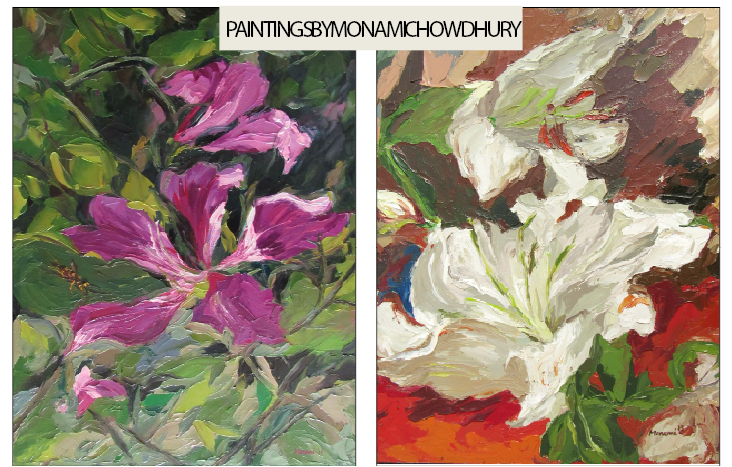Monami passed BVA (Bachelor of Visual Art) from Indian College of Arts & Draftsmanship, Kolkata in applied arts in the year 2002, MVA in Graphics (Print Making) from Rabindra Bharati University, Kolkata in 2006. She was interested in art making since her childhood. After completing Higher Secondary she took admission in Academy of Fine Arts and had her initial training there. After one year of study there she joined Indian Art College and simultaneously took lesson from a well known artist Ashok Roy from 1997 to 2002. Roy could realise her interest in flower and inspired her to carry on with this subject. It is from his guidane that Monami earned her perfection in applying thick colour with spatula. She mostly prefers oil based colour than acrylic. After completing MVA she engaged herself completely to he own practices. But she made her first solo show at Academy of Fine Arts, Kolkata in 2002, the year she completed her graduation. Her second solo was held in the same gallery in the year 2008. After that her solo and participation in various group shows continued, which extended her identity a promising painter to the art lovers and connoisseurs. Her third solo was held during 2009 at Chemould Art Gallery, Kolkata, fourth at Master Collection Art Gallery, Kolkata. During 2013 and 2016 she exhibited at Taj Bengal, Kolkata. From 2003 till date her participation in different group shows are manifolds. She received certificate of merit from Academy of Fine Arts in 2006. These are success her success stories. She earned it by dint of her commitment to creativity. The present show at Academy of Fine Arts is her seventh solo.
Through flowers Monami enters into the beauty and mysticism of nature. Vincent Van Gogh once said: ‘If you truly love nature, you will find beauty everywhere’. Monami’s endeavours prove the truth of this assertion of the great artist. Flower is the emblem of beauty, so symbol of truth. It is self sufficient in itself. It is firm in its own identity. The well known American author Marianne Williamson (b. 1952) said: ‘A tulip doesn’t strive to impress anyone. It doesn’t struggle to be different than a rose. It doesn’t have to.’ The flower has no complaint against the world or anything. It thinks itself blessed to have the existence, as we listen to the song of Rabindranath: ‘Phul bale dhanya ami matir pare’. (The flower says, blessed I am to have the existence on earth). With all these characteristics the flower may be considered as the ideal creation of nature. This may be one of the reasons that most of the artists throughout the world have painted flower on some occasions or during some part of their life.
Monami says, ‘the light and shade of flower attracts me very much’. This statement reminds us of the flower paintings by Dutch baroque woman painter Rachel Ruysch (1664-1750), who was famous for her still life paintings with flowers. Creation of a mystic environment with chiaroscuro or contrast of light and shade was a special characteristic of baroque painting. In Rembrandt’s paintings we find the supreme development of this. However in such a painting of 1700 titled ‘Flowerpiece’ by Rachel Ruysch we find a bouquet of jubilant colourful flowers in a vase against a deep dark background. Even there is darkness within the blank spaces between the flowers. This contrast of light and shade brings a different vision rather than mere beauty of the flowers. This is how an artist tries to enter into the existential truth of the life. Monami’s rendition is far from the baroque sensibility, yet she too in her own way expresses her world outlook though her flower paintings.
Despite serious rebelliousness and discontent in expressions there are artists, who yield to flower to have a glimpse of glory. The Mexican artist Freda Kahlo (1907-1954) may be an example. Her paintings are mostly expressions of severe pain and unrest, yet when in some of her self-portraits she decorates herself with flowers, it hints at her vision of light. Flower may often appear as a symbol of terrific agony and torment. A painting by our Delhi based contemporary artist Arpita singh (b. 1937) titled ‘Girl on a Lotus Leaf’ of 1995 shows a nude woman seated on a wooden stool holding a bloomed lotus covering her vagina.
Monami’s flowers do not express rebellion or discontent. She is positive in her world outlook and approach towards life. There is, however, presence of shadow. She plays with the contrast of light and shade. But through that chiaroscuro she endeavours to bring the essential transcendence of her inner feelings. Her basic formal structure is naturalistic, the trend in which she was trained in her art college especially during her graduation. During her post-graduation, where she practiced graphics, particularly the technique of etching, she had to undergo process of fragmentation or disintegration of form. That experience might have instilled in her the trend of breaking up the natural. So through distortion in the process of post-impressionist trend she brings out an orchestration of shapes and hues.
Through this orchestration she brings the glamour and glory of her expressions. The textures created by application of pigment in thick layer by spatula add a notable dimension to her creativity. Through enlightened application of colours like alizarin crimson and purple and contrasting it with white she brings a flavour that is soothing and agitating at the same fold. Through this contrast she surpasses naturalness and creates a reality of her own. A painting always creates its own reality surpassing the naturalistic one.
Monami appeared to the field of creativity during the first decade of twenty-first century, when conceptualism was a primary trend. But she remained faithful to the modernist approaches and utilising all its essential qualities brought out equity in her thoughts and applications and has been able to create a spirit of transcendence.







